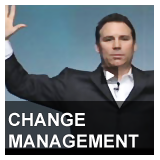Change Management Speaker
Garrison Wynn
The Real Truth about Change Management:
"Nobody wants to be a senior beginner."
How are your senior managers, mid-level managers and frontline supervisors equipped to manage resistance to change?
During organizational change, perception equals reality: The level of stress an employee feels during organizational change is proportional to the level of perceived threat. Managers need to anticipate and adjust their communication to minimize the perception of threat during change.
Garrison Wynn's change management keynote presentations address common problems leaders and change management teams face during mergers, acquisitions and organizational change using high-impact humor, research results from highly successfully managers and organizations, customized content based on interviews and/or change assessments with your key people.
Garrison is consistently chosen as the keynote speaker for events by Fortune 500 corporations, government, nonprofits, secular industry organizations and associations that want to move beyond the limitations of traditional "best-practices" and set breakthrough objectives to achieve maximum success. Read client testimonials and recommendations
Change is Mandatory...
Stress is Optional
Change is something we all have to deal with, but the stress that accompanies change is more of choice. In this heavily researched session, Garrison applies his signature humor to a very serious topic. This fun, comprehensive program offers tools and tips for getting through big change with very little stress. More importantly, it creates an emotional shift for attendees as they see how much control they have over how change affects them. This session also shows attendees how stress is more about what we believe than it is about what is actually happening. From embracing big transitions in technology to dealing with growth or downsizing, this presentation helps leaders, employees and customers implement necessary changes with minimal resistance.
 Our people really enjoyed your presentation. Very funny and spot-on with ideas about moving through change and communicating teamwork throughout our infrastructure. We had people there from all over the world and the feedback was great. Being so animated and clear made your humor work on a global level. Hewlett-Packard
Our people really enjoyed your presentation. Very funny and spot-on with ideas about moving through change and communicating teamwork throughout our infrastructure. We had people there from all over the world and the feedback was great. Being so animated and clear made your humor work on a global level. Hewlett-Packard
Change Management
Keynotes and Breakout Sessions
Making the Most of Difficult Situations:
Changing Markets, Changing Times
This funny, insightful change management keynote combines relationship building with no-fluff motivation and change to deliver real solutions in uncertain times. Change management speaker and business relationship expert Garrison Wynn examines the challenges we face and shows how we can laugh at our problems while using them as catalysts for success. This session covers a lot of ground and provides no-cost, easily implemented, proven solutions that your people can use right away.
Inquire about this program
The Real Truth about Success: What the Top 1% Do Differently and Why They Won't Tell You
A decade of Wynn Solutions research reveals what makes owners and managers of top-performing businesses so effective–and it's not what you'd expect! If you enter this keynote session expecting to learn all about best practices and superior products, you'd better read the title again.
Standout success in a difficult economy often comes from personal advantage–whether it's tied to appearance, leadership-style communication, personality, resources or access to privileged information. Top performers rarely acknowledge this because it tends to make their success sound less impressive or undeserved.
Prepare to laugh and learn as Garrison leads program segments that include:
- Lies about success–and why we believe them
- From interview to confession: The research
- Why would anybody want to be in a fair fight?
- Create your own advantage in leadership and business development
- The truth about success™
- Being the best vs. being consistently chosen
- Action and adaptability create opportunity
- Establish a repeatable process for success
 You have really done great work for us and we can see a difference in our people and our ability to handle this transition. We knew your reputation before you came in but I must admit I'm surprised things have improved so much. Shell IT
You have really done great work for us and we can see a difference in our people and our ability to handle this transition. We knew your reputation before you came in but I must admit I'm surprised things have improved so much. Shell IT
 Garrison's change themed keynote program received excellent feedback and his leadership breakout got great reviews and was very well attended. Experience with a military audience and leadership structure is must for our group and we like the way you tied things together. Outstanding job! American Society of Military Comptrollers
Garrison's change themed keynote program received excellent feedback and his leadership breakout got great reviews and was very well attended. Experience with a military audience and leadership structure is must for our group and we like the way you tied things together. Outstanding job! American Society of Military Comptrollers
During change, one of the most important elements for success is management's ability to listen and communicate effectively. Leaders that can consistently challenge, motivate, and educate their people through change are successful.
How are your senior managers, mid-level managers and front-line supervisors equipped to manage resistance to change?
- Research on corporate culture has shown that organizations will not be able to sustain excellent performance over the long haul unless they have a corporate philosophy allowing them to adapt to a changing environment.
- A survey of 500 executives concluded that resistance was the main reason why organizational changes fail.
- A recent study found that 60% of the reengineering projects that failed were due to employee resistance.
- Critical management mistakes during change: learn how to avoid them
- Receiving collecting feedback and creating open communication
- Overcoming employee resistance to change
- Obtaining support from all levels
- Effective ways to approach the change management process
- The greatest contributors to the success of a change management program
- Defining the role of top management
- Discovering the most effective methods of communication
- A good change management team member: what are the most important criteria?
Communicating change objectives: for management
- How to be right without making others wrong
- The truth about team building: myths and motivators
- Creating a plan for success: what the most successful do differently
- The flywheel effect: making change work
- How create consistency without robbing people of their uniqueness
- Listening like a leader: the truth about trust
- How to get people to listen to you
- How top auditors succeed: our customized research
Creating an open environment for telling the truth
- How to help people move through change comfortably
- The three reasons people don't tell the truth
- Job protection vs. action
- How to avoid blame distribution
- Focusing on what's important: picking your battles
- How to increase employee accountability and buy-in
Everything you ever wanted to know about effective questioning techniques but were afraid to ask
- How to create the defined outcomes you want your questions to deliver
- Creating questions that identify needs without bruising egos
- The five best questions in the world
- How to customize the best questions for your audit process
- Open- and closed-ended questions and how to use them
- How to identify issues that are not being discussed
- How to detect the reoccurring patterns of dishonest answers
Face-to-Face Communications
- Being prepared: when you are on the firing line
- Organized information gathering techniques
- Effective processes: ask, listen, agree, and recommend
- How to avoid an argument
- How get people to agree with you
- How to build rapport quickly: relationship management
Body language and eye contact: yours and theirs
- Voice tone and sincerity
- Overcoming objections
Managing expectations and emotions
- Developing the most common objections in advance
- Isolating objections and handling them one at a time
- Understanding the difference between objections and conditions
- Why objections indicate interest
- How to treat objections as a request for more information
- Handling objections without being defensive
Structuring and delivering your solutions
- Using the flywheel effect: proving change works
- Creating awareness
- How to make their ideas part of the solution
- Outlining the benefits of a consistent approach
- How to guide people from resistance to acceptance
- How to clearly explain the value of your solutions
Presenting your ideas
- Lay the foundation: defining your goal
- How to outline your concepts for maximum impact
- How to create a concise presentation from too much information
- Structure and flow: professional presentation skills
- Speaking with passion and confidence
- How to a create value proposition
![]()
Communicating change management
How management can motivate people to listen
Resistance to change is the issue.
Change happens; and while we can't control much of the world changing around us, we can control how we respond.
We can choose to anticipate and embrace changes or resist them. When things change, people are afraid they will no longer be experts. They will have to learn the new way, and no one wants to be a continuous senior beginner. Our studies show that to make change work, we have to prove to our key people that the change means getting better (or at least equal) results than the old way, assure them that their experience has value, and then get them to spread that message through the organization.
When you tell someone you know exactly how they feel, you rob them of their uniqueness. Our three-year study of top communicators showed that when someone tells you their core issues and you say, "we had a situation exactly like that last month, and as a matter fact the guy looked just like you, and this is what we did," you create your own resistance. They will then try to show you how their problems are special and need more of your attention. However, if you acknowledge the difficulty of their problem and then share your experience in similar situations (the key word being similar), they are more likely to use your solutions.
The manager as a change advocateWhen managers and front line supervisors communicate well with employees, understanding their fears and misgivings, they can find ways to not only help employees through the transition, but to involve employees in the process thereby building ownership for the change and increasing accountability
Sending a clear and united message
Research shows that executive involvement is the greatest contributor to change management success..If people don't know "what" the change is and "why" it's being implemented, then "how" to implement the change is a mute point. Change leaders must show alignment with senior management's business objectives and back up words with behaviors and actions that support change.
Managing the Journey: A formal communication plan for change
It is important for executives to communicate a structured change process showing where the company is going, how they are going to get there and what results they expect at the end.
Resistance management (tactics for systematically managing resistance)
The eight most common beliefs and reasons that people resist change
- There isn't any real need for the change
- The change is going to make it harder for them to meet their needs
- The risks seem to outweigh the benefits
- They don't think they have the ability to make the change
- They believe the change will fail
- Change process is being handled improperly by management
- The change is inconsistent with their values
- They believe those responsible for the change can't be trusted
Making change work: The flywheel effect
Doing more with less: Increase productivity
People want to have more organized communication systems and be on the same page with how they are communicating. Managing change requires learning the best form of communication for change related issues. For example: when to use email, when to use voice mail, when to have face-to-face meetings, when upper level management needs to show up and be heard.
The toughest challenge of organizational leaders today is to manage at the speed of change. With the pace of technological advancement and the knowledge explosion, leaders face tremendous pressure as they attempt to gain support for change. While resistance is always a problem, it is especially harmful during an economic slowdown. Regardless of how good or necessary a change may be, resistance should be expected.
The fewer moving parts something has, the less likely it is to break down. Before you decide that everyone has to become more organized, you might want to simplify the system as much as possible. (Be careful! Simplification can get complicated!) After you have done all you can, providing training that begins with clearly defined outcomes and includes hands-on experiential learning techniques can have maximum impact on your organization's belief systems.
Change Management Articles:
Please contact change management speaker Garrison wynn for additional program information, availability or pricing.










